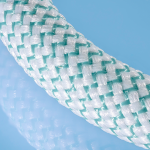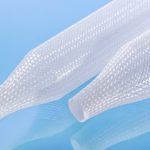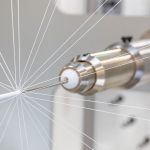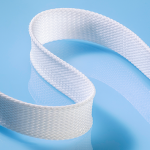30 Aug Engineer Spotlight: Cortland Biomedical’s Maddy Moncla Discusses Our High-Density Braiding Capabilities
CBM Development Engineer Maddy Moncla discusses the advantages and use cases for high-density braiding.
 Can you describe the high-density braiding process and what sets Cortland Biomedical apart in its capabilities?
Can you describe the high-density braiding process and what sets Cortland Biomedical apart in its capabilities?
To create a high-density braid, you first begin with a large package of raw material, i.e., fiber. The fiber is then split into a desired number of braider bobbins. These bobbins will be loaded into the braiding machine, where they will all contribute to create a braid. Half of the bobbins will travel clockwise, and the other counterclockwise. The bobbins will weave in and out between each other. Overlaps of the material in this fashion create a hollow, tubular braid. This braid can either be formed over a mandrel, or independent of any structural aid, depending on the application. At Cortland Biomedical, we have a variety of bobbin counts for our high-density braiders, and each machine can offer continuous or discrete units. We can create a braid with up to 144 ends! The individual braid ends can be different materials, colors, and sizes. The formation of the braid can be over almost any item or shape, and the braid wall can be designed to be thick or thin.

One of our machines is essentially a braider inside of a braider. This allows the outer and inner ring to both run together at the same time, forming one unique braid on top of the other – we call this a core and jacket. This is a great braiding capability for certain applications where the product needs to hit a certain strength target with low programmable Picks Per Inch (PPI), which refers to the braid density. Having an outer ring/jacket can allow us to incorporate qualities that may be totally opposite from the core braid. This is important when we’re designing any tensile strength member that may need a unique outer surface.
Cortland Biomedical also offers the benefit of rapid prototyping. When it comes to iterating high-density braided products, we can perform multiple trials for our customers while the material is still on the braider by quickly changing braider settings. This way we can produce multiple braid designs with different characteristics without requiring much additional setup time.
You can differentiate up to 25 segments – can you elaborate on what this means and why it’s beneficial?
 Overall, this lets us create highly customized geometries – whether our customers want open structures or very closed structures. Segments of a braid can be thought of as independently designed sections. These sections consist of different braid densities, or PPI, as well as custom lengths. For example, there may be segments where you want a loose open structure; we can design that into a continuous run. Or, if we’re creating something with a funnel shape, each segment contributes to helping the braid conform.
Overall, this lets us create highly customized geometries – whether our customers want open structures or very closed structures. Segments of a braid can be thought of as independently designed sections. These sections consist of different braid densities, or PPI, as well as custom lengths. For example, there may be segments where you want a loose open structure; we can design that into a continuous run. Or, if we’re creating something with a funnel shape, each segment contributes to helping the braid conform.
Segments continuously repeat. Because our machine can remember and run up to 25 segments, we can produce repeat units consistently and efficiently.
What are the benefits of having the ability to process both discrete or continuous products?
High-density braids offer excellent coverage with minimal thickness. Discrete high-density braids offer excellent cover for any internal units that need to be contained inside a sleeve.

Discrete units — typically braided over a stainless-steel mandrel to establish a hollow inner diameter — are commonly run through a variety of post processing methods for customization. This includes heat setting or laser cutting into unique shapes. The only limit to discrete units is the length of the mandrel required for the certain application.
Continuous length braids can later be placed over a mandrel of a certain size for any post processing required. They can be used as tensile strength members of any length required. A high-density braid can also be ‘flattened’ and have the similar dimensions as a woven tape. This can also be used as a tensile strength member.
How does braiding over straight and tapered mandrels allow for complex geometries in high density braided structures?
Textiles like to conform to all sorts of shapes; this is one of their most desirable properties! When braiding using a high-density braider, we can use a rigid object to influence the outputted shape of the braid. The braid geometry will immediately want to conform 360 degrees to match any unit, whether it is a perfect cylinder, or a rod with tapered ends. Combining complex geometries, as well as individually designed segments of these braids, can allow us to customize the textile to match any custom application and coverage.
What scenarios are ideal for high-density braiding?
 We tend to gravitate towards high-density braids in scenarios that necessitate a lot of design flexibility and custom geometries. These braids can either be really bulky or very thin and hollow — much more so than low-density braids. High-density braiding is also a good option when the customer has a lot of post-processing requests, such as laser cutting or heat setting.
We tend to gravitate towards high-density braids in scenarios that necessitate a lot of design flexibility and custom geometries. These braids can either be really bulky or very thin and hollow — much more so than low-density braids. High-density braiding is also a good option when the customer has a lot of post-processing requests, such as laser cutting or heat setting.
If a customer was looking for a delivery component or sleeve for other device components with a determined diameter, we would point them in the direction of a high-density braid. These braids have the capability to combine high coverage with flexibility. To achieve a fixed diameter, we can braid over a rigid object with an established diameter and then heat set it. No matter what you do to it afterwards, the braid will bounce back to the target diameter.
On the other hand, I would also recommend a high-density braid for a request for an open, continuous structure. High-density braids can also be manufactured very ‘open’ to promote cell growth.


